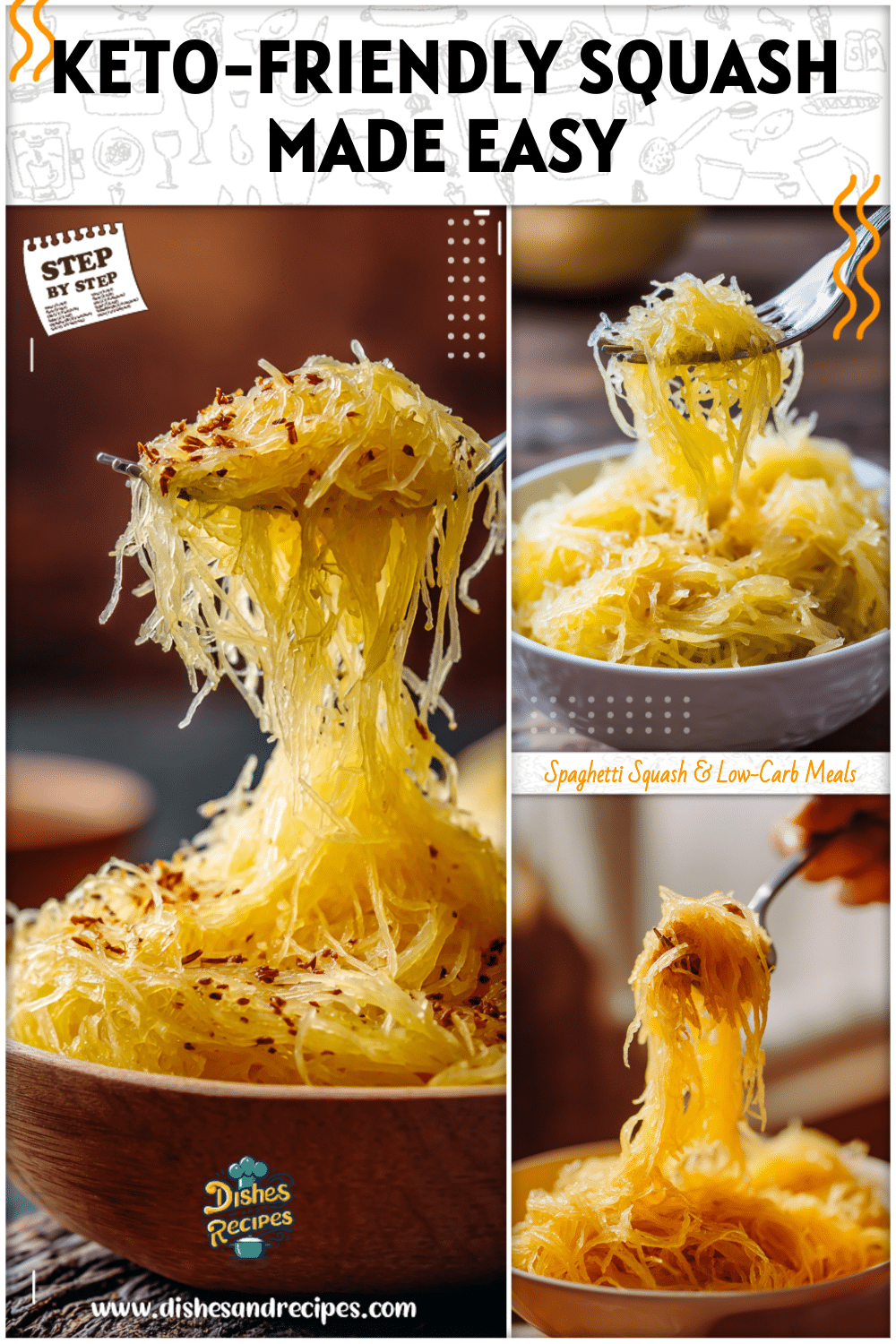When starting the keto lifestyle, one of the big challenges is finding hearty substitutes for carb-heavy favorites like pasta. That’s where spaghetti squash often comes into the conversation. Many people wonder: is spaghetti squash keto and does it actually fit into a low-carb lifestyle? This versatile vegetable has gained attention for its noodle-like strands and mild flavor that pairs beautifully with sauces, proteins, and healthy fats. In this article, we’ll explore whether spaghetti squash is keto-friendly, its nutrition facts, and how to cook it with an easy baked recipe—plus answers to the most common keto-related spaghetti squash questions.

Why Spaghetti Squash is Loved in Keto Cooking
Memories with Spaghetti Squash on the Table
When I first started experimenting with keto recipes, I assumed pasta was completely off the table. That cozy bowl of noodles dripping with sauce felt like a distant memory—until I stumbled upon spaghetti squash. The first time I sliced one open, baked it, and pulled at the tender flesh with a fork, I was genuinely amazed. The strands separated into golden ribbons, resembling spaghetti more than I expected.
It was almost magical: here was a vegetable that could mimic one of my comfort foods without pushing me out of ketosis. That moment answered the question I had often asked: is spaghetti squash keto enough to replace my pasta cravings? The more I incorporated it into my meal plan, the clearer it became that not only did it fit keto macros, but it also made sticking to low-carb eating enjoyable.
Over time, I’ve built memories of placing baked spaghetti squash on the dinner table, watching my family twirl the strands with their forks, and realizing they didn’t miss the traditional pasta. For anyone exploring a keto lifestyle, discovering this vegetable feels like unlocking a secret weapon—a true game-changer for weeknight meals.
Print
Easy Baked Spaghetti Squash
- Total Time: 50 minutes
- Yield: 4 servings 1x
Description
A simple keto-friendly recipe for baked spaghetti squash that yields tender, noodle-like strands perfect for low-carb meals. Ready in under an hour with minimal ingredients.
Ingredients
Instructions
1. Preheat your oven to 400°F (200°C).
2. Wash the spaghetti squash thoroughly.
3. Carefully cut the squash lengthwise down the center.
4. Scoop out the seeds and stringy pulp with a spoon.
5. Drizzle each half with olive oil and sprinkle with salt and pepper.
6. Rub minced garlic onto the flesh if using.
7. Place the squash halves cut-side down on a baking sheet lined with parchment paper.
8. Bake for 35–40 minutes, until the skin is tender when pierced with a knife.
9. Let cool for 5–10 minutes before handling.
10. Use a fork to scrape the flesh into noodles.
11. Serve topped with butter and parmesan or your choice of keto-friendly sauce.
- Prep Time: 10 minutes
- Cook Time: 40 minutes
Nutrition
- Calories: 42
- Sodium: 230
- Fat: 0.5
- Carbohydrates: 10
- Protein: 1
What Makes Spaghetti Squash Different from Other Veggies
Spaghetti squash stands out from the rest of the vegetable aisle because of its texture. Unlike zucchini, which softens into spirals when cut into “zoodles,” spaghetti squash actually transforms during baking. You don’t need any special gadget except a fork to reveal its delicate strands, which come surprisingly close to the look and experience of pasta.
In terms of taste, it has a very mild flavor—lightly sweet but not overpowering—making it the perfect base for sauces. From creamy Alfredo to garlic butter or marinara, spaghetti squash absorbs and blends flavors effortlessly. That quality is what keeps it on so many keto meal prep lists.
Another benefit is that it’s naturally gluten-free, which adds versatility for anyone combining keto with gluten sensitivities. And unlike some denser vegetables, a single cooked squash can be portioned into multiple meals. This makes it easy to prep ahead, store, and pull out whenever you’re craving a warm, low-carb dish.
For keto eaters specifically, the appeal goes beyond novelty. It’s about sustainability: finding replacements that don’t feel restrictive. That’s why so many people keep returning to spaghetti squash—it’s comforting, filling, and feels far closer to pasta than most alternatives, making the answer to is spaghetti squash keto not just “yes,” but “yes, and it makes keto easier.”
Is Spaghetti Squash Keto-Friendly? Understanding Nutrition Basics
Carbs and Net Carbs in Spaghetti Squash
When asking is spaghetti squash keto, one of the first things to check is its carbohydrate content. On keto, carbs need to be tightly managed, making net carbs (total carbs minus fiber) the true figure most people track.
Here’s a breakdown of the nutrition in 1 cup of cooked spaghetti squash (about 155g):
| Calories | ~42 |
| Total Carbohydrates | 10g |
| Fiber | 2g |
| Net Carbs | 8g |
| Protein | 1g |
| Fat | 0.5g |
With only about 8 grams of net carbs per cup, spaghetti squash is lower than traditional pasta by a landslide. For reference:
- Regular spaghetti (1 cup cooked): ~43g net carbs
- Zucchini noodles (1 cup): ~2–3g net carbs
This makes spaghetti squash a fantastic middle-ground keto pasta substitute. It’s slightly higher in carbs than zucchini noodles, but far lower than wheat pasta, offering a satisfying, pasta-like texture without blowing your carb allowance.
Does Spaghetti Squash Fit Keto Macros?
So, is spaghetti squash keto when working within daily macro goals? The answer is yes—as long as portions are considered. Most people on keto aim to stay under 20–30 grams of net carbs per day. That means a cup of spaghetti squash at 8g net carbs can be comfortably included, especially if paired with lower-carb sides during the rest of the day.
The trick is balance. For example, enjoying one serving of spaghetti squash topped with creamy Alfredo sauce and chicken thighs gives you plenty of protein and fat while keeping carbs controlled. Even two servings (around 16g net carbs) can still fit in if the rest of your meals are higher in protein and fat but minimal in carbs—think eggs, avocado, cheese, or leafy greens.
Here are a few tips for fitting spaghetti squash successfully into your keto macros:
- Keep portions reasonable: Stick to 1–2 cups, depending on your carb limit.
- Pair it with high-fat toppings: Butter, olive oil, parmesan, or pesto help balance macros.
- Add lean proteins: Chicken, shrimp, ground beef, or sausage makes it filling and keto-approved.
- Batch-prep for the week: Bake a squash, portion it out, and use as the low-carb base for multiple meals.
In short, spaghetti squash fits seamlessly into a keto diet when portioned wisely. It allows you to enjoy a beloved comfort food while protecting your carb limit—answering the big question, is spaghetti squash keto, with a reassuring yes, absolutely.
Cooking Made Simple – Easy Baked Spaghetti Squash Recipe
Ingredients and Kitchen Tools You’ll Need
One of the best things about cooking spaghetti squash is its simplicity. Unlike making fresh zucchini noodles or preparing traditional pasta, there’s very little fuss involved. All you need are a few pantry staples, plus one bright yellow squash as the star of the show.
- Ingredients: 1 medium spaghetti squash (2–3 lbs), 1–2 tbsp olive oil, ½ tsp salt, ¼ tsp black pepper
- Optional toppings: garlic, butter, parmesan, pesto, Alfredo, marinara, fresh herbs
- Kitchen tools: sharp knife, spoon, baking sheet, fork, oven mitts
Step-by-Step Baked Spaghetti Squash Recipe
Step 1: Preheat and Prepare – Preheat your oven to 400°F (200°C). Wash the squash thoroughly.
Step 2: Cut and Clean – Carefully slice the squash lengthwise and scoop out seeds and pulp.
Step 3: Season the Squash – Drizzle with olive oil, sprinkle salt and pepper, and add garlic if desired.
Step 4: Bake Until Tender – Place halves cut-side down on a baking sheet. Bake for 35–40 minutes until tender.
Step 5: Shred the “Spaghetti” Strands – Let cool slightly, then scrape with a fork to release noodle-like strands.
Step 6: Serve It Keto-Style – Enjoy with butter, cheese, or keto-friendly sauces.
Pro Tip for Meal Prep: Bake one or two squashes ahead, shred them, and refrigerate in portions for easy, quick meals throughout the week.
FAQs About Keto and Spaghetti Squash
Is spaghetti squash better than zucchini noodles for keto?
Both are good options. Zucchini noodles are lower in carbs, but spaghetti squash offers a heartier, pasta-like experience.
How many net carbs are in spaghetti squash per cup?
One cup of cooked spaghetti squash contains about 8g net carbs—far lower than traditional pasta but higher than zucchini noodles.
Can you eat spaghetti squash every day on keto?
Yes, in moderation. One cup per meal fits easily into keto macros, but multiple cups daily may exceed your carb limit.
What’s the best way to store baked spaghetti squash?
Store cooked strands in the fridge for 4–5 days or freeze portions for up to 2 months. Reheat on the stove or microwave.
Does it taste like real spaghetti?
Not exactly—it’s slightly sweet and nutty but absorbs sauces beautifully, creating a pasta-like experience that satisfies cravings.
Final Thoughts
So, is spaghetti squash keto? The answer is a confident yes. With around 8g net carbs per cup, it’s a low-carb, gluten-free, and flavorful swap that helps make keto sustainable. It’s versatile enough to carry creamy sauces, pair with proteins, or stand alone with butter and cheese. Best of all, it’s family-friendly and meal-prep ready.
If pasta is what you miss most on keto, spaghetti squash offers the closest comfort without derailing your carb limit. Bake one this week, pair it with your go-to keto toppings, and discover how this vegetable can make your low-carb journey more delicious, enjoyable, and achievable.














